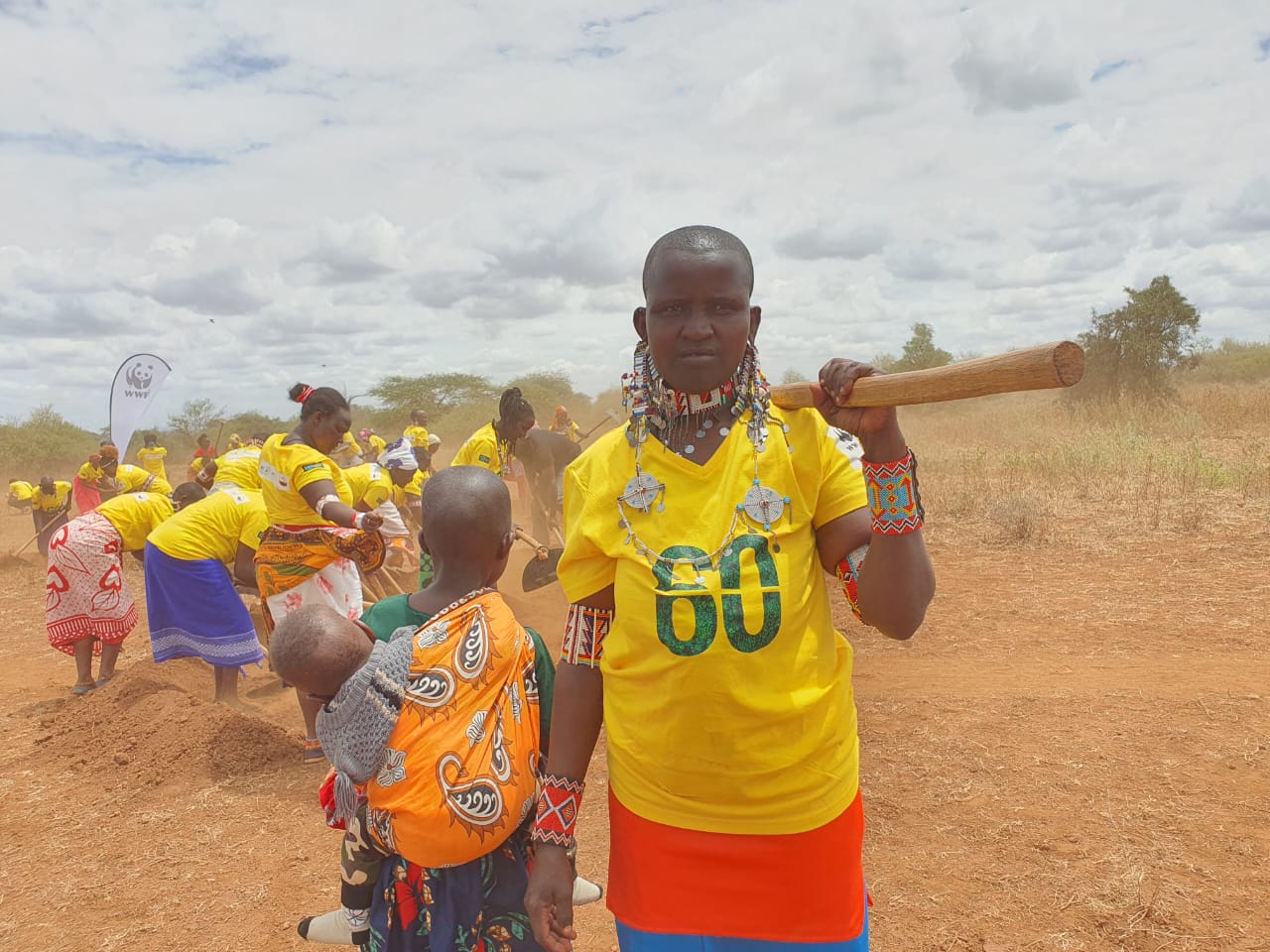
Half-moon bunds project restoring fortunes of a community in Amboseli

In Amboseli Local Community Conservation Area, at the heart of the Amboseli ecosystem, the morning unfolds with a ritual that has become all too familiar for its female inhabitants.
Nonosio Kuyalo rises from her makeshift house, her weary eyes reflecting the weight of yet another day’s struggle. She wraps a worn-out shawl around her shoulders, the fabric frayed from years of use, and steps outside into the relentless heat. Behind her is her seven-year-old daughter, who tags along.

Kuyalo, with her nine-month-old toddler tied on her back, narrates how the quest for a piece of daily bread is not just a daily chore but a back-breaking endeavor.
She is 28 years old and the mother of seven children. She tells KBC Digital that she is the third wife in her homestead and that she has had to fend for her family to make ends meet, given that her husband has long neglected his financial and other household responsibilities.
According to Kuyalo, she, along with her co-wives, resolved to join a group of other women working in the conservancy. Their task involves digging out half-moon bunds, earning them a compensation of Ksh 150 per bund. This is what feeds, clothes, and schools their children.

are semi-circular soil structures that conserve water and prevent erosion. They have proven to be effective in enhancing soil fertility, restoring degraded lands, and mitigating the impacts of climate change.
Kuyalo says the bunds project, meant to green the conservancy, has been a relief for her and her homestead, particularly in light of their difficult circumstances.
“Before the drought, we had some cows which used to sustain us financially. We would sell the manure and milk produced to get some money for food and school fees. However, during the drought, all our cows died because they did not have neither food nor water. This was the beginning of our troubles as a household,” she says.
Kuyalo says she is engaged in the project for long-term gains, particularly for her community.
A few meters away, Sikeita Ene Laisa draws our attention, draped in her traditional Maasai wear, she is digging one of the bunds under the scorching sun, but she seemed unfazed.
As I approach her, the momentum slowly moderates, and she accords us the audience. On asking, Sikeita says her motivation for the current project emanates from her realization that she finally got a chance to earn a living and positively contribute to her community.

“Maasai women used to stay in the house from time immemorial, but now, we are empowered. We earn a living from this project, and with the proceeds, we engage in table banking. My children are all currently in school because I have a small loan I took out from the group,” she says.
And that’s not all. Laisa says that once the grass matures, the community will have a constant source of livestock feed, alleviating the challenge of having to buy feed at exorbitant prices and the trouble of having to trek many kilometers to graze their cattle.
Samuel Jakinda, a Program Manager for Amboseli and South Rift landscape at Just Dig It, says owing to the highly degraded land in ALOOCA, his organization took up the half-moon bunds project to restore the land using nature-based solutions.
“We mostly use rainwater harvesting interventions as our prime tool to restore degraded landscapes. Our interventions slow down the movement of water aiding it to infiltrate into the ground,” says Jakinda.
According to Jakinda, the bunds, also known as earth smiles, have turned around the economic fortunes of the locals, citing the employment opportunities for the women involved.
“We are establishing a company, Landscape Restoration Enterprise, which will buy grass seeds from the women groups. LRE will then support them by giving them technical assistance by packaging the seeds for other actors who want seeds. This will aid in continuity of their enterprises even after our exit,” he avers.

The market rate for the seeds is Ksh 1000 per kilogram, while the cost of one bund is Ksh 500.
On his part, Dr John Kioko, WWF-Kenya Programme Coordinator, Amboseli-Chyulu Sub-landscape, during the Earth Hour 2024 celebrations in ALOOCA, said that the fete is meant to bring community members and organizations together to inspire each other on how to take care of the earth.
Dr Kioko says that the project is aimed at restoring 20,000 hectares of land, 5,000 of which will be done directly.
“The water bunds do not only capture and retain the rainwater, they also make sure that the water running downhill in between them is slowed down avoiding soil and water erosion. Large areas can be greened quickly by digging bunds, which significantly impacts biodiversity, nature, people, and the climate,” he notes.
By simply focusing on the bunds, Dr Kioko says; “We can conserve rainwater runoff, replenish groundwater, and provide a sustainable water source for local communities and wildlife.”
Amboseli is among the regions facing the adverse impacts of climate change, including prolonged droughts and extreme weather events.
Experts believe Half Moon Bunds act as a climate resilience measure by retaining moisture in the soil, thus supporting plant growth during dry spells. Additionally, the enhanced vegetation cover is said to help in carbon sequestration, contributing to climate change mitigation efforts.
In the meantime, engaging local communities in the construction and maintenance of the bunds fosters a sense of ownership and empowerment. It now provides livelihood opportunities through skills development, employment, and sustainable agriculture practices. Moreover, community involvement ensures the long-term sustainability of conservation efforts in ALOOCA.

